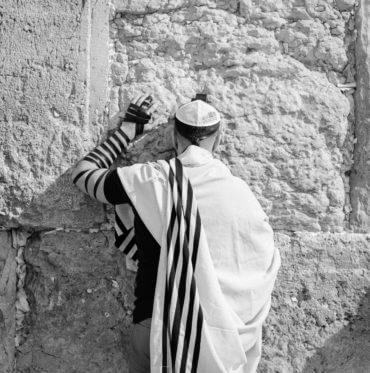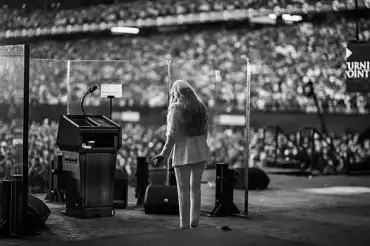What I Love Most About My Fellow Jews
Too often, we see the worst in each other. This is true of all people and especially, and unfortunately, the Jewish people. We see the most extreme and negative element of the communities we don’t belong to while the more moderate and pleasant people among them hide under the radar. We often fail to see how each and every community has its strengths which adds to the wondrous tapestry of the Jewish people.
When we received the Torah as a nation, the commentator Rashi said we were “ki ish echad balev echoed” – like one man with one heart. That was a high point of our unity as a nation. But then we fell. For the last two thousand years, we have suffered through a long and painful exile due to baseless hatred. In the hopes of meriting a rebuilding, what better way to build than to build up? Publicly build up our fellow Jews. Our family. Please comment on what you love most about yours. Here are mine:
Chasidim My first up close and personal experience with chasidim started in college when I met an extraordinary family on a shabbaton in Lakewood, New Jersey. When I entered their house before shabbos, they sat me down with a piece of hot potato kugel then led me to my room where my bed was bedecked in the finest sheets and comforter. On shabbos morning, I awoke to homemade pastries that only chasidim can bake, and when shabbos ended, I was sent home with one of the scrumptious challahs so that I could carry a piece of that wonderful shabbos with me the following week. When I gave birth to my oldest child in Israel, Satmar Bikur Cholim served me practically the same shabbos food I had grown to love from this friend’s house. Tiny containers of fish and cholent and kugel – everything homemade and delicious. So much attention to detail and care put into each piece. The chasidim are masterful in their acts of chesed.
Sephardim I worked at an organization called Partners in Torah for my first job out of college. While I was there, I spoke to 3000 Birthright alumni, including hundreds of young Sephardic Jews. I would often ask in these phone interviews where the student stood in terms of belief in God and Torah. 9 times of out 10, the Sephardic Jew I spoke to didn’t just tell me “yes, I believe in God,” he told me “Of course I believe in God.” For many Ashkenazi Jews, faith is more difficult to come by. We doubt, we second guess. Not so with the Sephardim. My husband once remarked that he loves praying in Sephardic shuls because when the Torah comes out, there is a respect and a knowledge among the entire congregation: “THIS is the Torah that Hashem gave to Moshe.” The Sephardim are masterful in their faith.
Yeshivish In the Shema, we’re commanded “v’debarta bam” – “and you should speak of them.” When should you speak of them – i.e. words of Torah? “When you sit at home, and when you walk along the way, and when you lie down and when you rise up.” The Yeshivish community, which centers its life around the yeshiva and learning Torah, has shown me the greatest example of this mitzvah. I once was at a friend’s house for a shabbos meal while two of her Yeshivish brothers were visiting. They were so engrossed in the Torah they had been learning, they discussed it and argued about it passionately, ribbing each other as only brothers can do and brought it to life for everyone in the room. I sat there in awe in how they pored over it and delighted in it. The Yeshivish community is masterful in their commitment to Torah study.
Modern Orthodox We show many examples of Orthodox Jews living integrated lives here at Jew in the City which is probably the greatest strength of the Modern Orthodox community. One example that stands out for me in how powerful an integrated Torah observant life can be is The Maccabeats’ viral hit, “Candlelight.” Millions of viewers around the world saw these delightful young men – fun, approachable and “normal,” yet clearly committed and moved by their Jewish rituals and Torah study. I can’t imagine how many Jews who watched their video realized that Jewish observance need not transform them into a foreign version of themselves. Indeed, the Torah is accessible to Jews no matter where they are. The Modern Orthodox community is masterful at showing how to live an integrated observant Jewish life.
Chabad From Venice to Cancun to Amsterdam to Melbourne and sometimes even in New York City, no matter where I have been, if I’ve had a Jewish need, Chabad has been there to help. But the Lubavitchers I am most moved by is a couple I never met, yet am deeply bound to. In the spirit of Chabad’s willingness to go to every corner of the earth, Gavriel and Rivky Holzberg opened a center in Mumbai to feed and house and offer Jewish services for anyone who passed by their door. The day the terrorists came to take hostage this beautiful couple (who had first unknowingly hosted them as guests) I gave birth to my older son. When these despicable people murdered this husband and wife a few days later, my husband approached me in the hospital and asked if I wanted to add “Gavriel” to our son’s name to remember and carry on their legacy. I couldn’t think of a better way to respond to the tragedy. Lubavitchers are masterful at being there for every Jew in every part of the world.
Non-Orthodox Although Jew in the City is an organization dedicated to breaking down stereotypes about Orthodox Jews and nearly all of our content is focused on them, as an Orthodox Jew, I would like to include our non-Orthodox brethren in this list too since we lack unity across the Orthodox/non-Orthodox divide and both sides could use to improve. Several years ago, I met a non-Orthodox Jewish woman who in college learned how many people in Africa were living in dire straits. No clean water, hardly any food or medicine. “So I got on a plane to go help,” she explained, “And I’ve been there ever since.” “You did what?” I asked, as chills ran down my spine. I was overcome with the magnitude of what I was hearing. “Yeah,” she continued, as if it was completely normal to leave a comfortable, stable Western life and live in a hut. “They needed help, so I went.” Though non-Orthodox Jews may not all adhere to strict Torah observance in the way that Orthodox Jews do, there are so many who are so deeply moved to care for the world and all of its inhabitants. They join the Peace Corps, Habitat for Humanity, Teach For America at unusually high percentages. These are the children of Avraham Avinu who live their lives doing chesed and embodying his traits. Non-Orthodox Jews are masterful at empathy.
What if we viewed our fellow Jews with admiration and worked to embody the best traits of their community? How different might our world look? Please share what you love about your fellow Jews too!
If you found this content meaningful and want to help further our mission through our Keter, Makom, and Tikun branches, please consider becoming a Change Maker today.








3 comments
Sort by
Love it there is so much to learn from all tyes of Jews in zechus of that may mariachi come soon and heal us all amen!:)
Love love love this article! Ahavas Chinam is just what we need right now!!!And just for some extra food for thought, Allison, I am a chassidish woman, living in Yeshivish Lakewood, who also has sephardi friends and lubavitch relatives, as well as some secular relatives as well. So we really are quite interconnected 🙂
I never thought about what I could learn from non-Orthodox Jews before. Allison, you have opened my eyes.